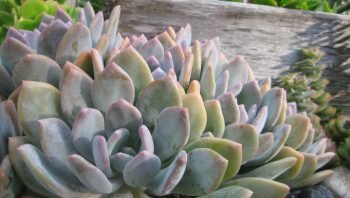Succulent: Graptoveria ‘Opalina’

Succulent plant formed by rosettes with narrow and long leaves up to 6cm in blue-green color with pink / red variegations on the tips and margins when grown in full sun. In late spring the inflorescences appear with yellow and orange flowers in the center.
Family: Crassulaceae
Origin: Madagascar
Care for Graptoveria ‘Opalina’:
Grow in a pot or in open ground with well-draining soil. Grow in a very bright or full sun position. If cultivated in ocher it tends to stretch to look for light and takes on faded colors. Irrigate moderately in the growing season and leave almost dry in the winter. It resists short frosts if kept dry
How to Propagate Graptoveria ‘Opalina’:
easy by leaf-cutting, just detach the individual leaves in spring/summer and place them on a soft substrate kept slightly moist
Like all succulent plants, Graptoveria is robust and easy to grow and reproduce. Exposure in full sun will help to develop all the beautiful shades of color of this plant.
Curiosity Graptoveria is a hybrid between Echeveria and Graptopetalum. The “X” that is sometimes found in front of its name indicates that it is not a species present in nature but a hybrid developed by nurserymen.
Etymology: In the name opal it derives from the similarity of the color of the leaves with the opal mineral which has a vitreous luster.
In reality, it is a cultivar or a hybrid derived from colored Echeveria x Graptopetalum amethystinum created by Roberto Grim and published in 1988.
Common names: often on sale as ‘blush’ (blush) even if in reality, it is another similar hybrid